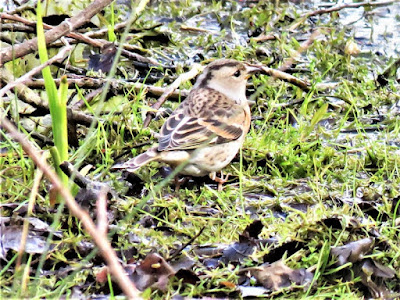One of the highlights was a pair of Egyptian Geese. Strange-looking birds placed taxonomically between 'geese' and Shelduck. There is a small feral population of these birds in the UK, a few of these locally. They originally escaped from wildfowl collections. Here the pair are photo-bombed by a wing-stretching first year Black-headed Gull.
The pair head down and calling in display. They were very noisy birds.
The large white panel in the open wing is rather unexpected.
Perhaps they ought to be called Trumpeter Geese.
And this was one cause of all the noise. An interloper third bird. A goose in a tree? Well you can have partridges in pear trees so why not?
A favourite duck of mine. A drake Gadwall.
And here stretching his wings while his mate drowns.
A sleeping drake Pochard in the sun. I have tried my best to adjust the photo to show the fine vermiculations on its back. To do so makes the head and neck look somewhat darker than in real life.
Amongst the gaggle of Tufted Duck the fourth bird from the left is a duck (Greater) Scaup with much white on the face and a rounded head shape. The bird second from left that looks superficially similar has less white on the face and I am sure is a duck Tufted Duck – the amount of white shown by this species is variable and many lack any white at this time of year.
A drake Tufted Duck powers by.
And now a gaggle of six drakes and a duck fly by. Note how the drakes' tufts are streaming in the wind – spivs!
There is a noisy breeding colony of Black-headed Gulls on specially constructed shingle islands. Here an adult in breeding plumage flies by.
There are also many non-breeding birds. This first year shows its wing pattern. Note it nevertheless has an adult-like full dark hood.
Another first year, this one with a rather blotchy head
The bird at the back caused some consternation when I first noticed it as it flew. The wings are totally white and I assumed it was an adult Mediterranean Gull. It is too small and the dark on the head is only a hood and not the whole head. Both these birds are first year Black-headed Gull, the back one being leucistic in having reduced or no pigmentation on some of its feathering. It is not just the wing-tips, the whole wing is much paler.
Another view of it here behind a different first year Black-headed Gull. This latter bird is another first year bird with an almost complete black hood and dark bill. Note though the brown in the folded wing never shown by adults.
The depression under the left hand bird is their nest scrape. A few minutes later it had an egg in it.
A size contrast here. A first year Black-headed Gull with a Common Sandpiper walking in front of it.
Another small wader dropped in – about the same size as the Common Sandpiper. This is a Little Ringed Plover. It can most easily be distinguished from the larger (Greater) Ringed Plover by its obvious yellow bare skin around the eye. It also has pale legs though that can depend upon where it has been wading!
In front of one of the feeders a Stock Dove was feeding on spilt seed. They are rather attractive birds with the glossy green (or blue depending on the angle of the light) patch of feathers on the neck instead of the white shown by Wood Pigeons.
They also lack white in the wing but show two dark bars across the folded wing. They are smaller and shorter-tailed than a Wood Pigeon.
With a delicate flush on their breast.
I am a bit bemused: as far as can I recall this was the same Sedge Warbler and here the bill looks normal. You can just see that above the black bordered eye-brow the crown is striped.
The stripes shows slightly better here.
Tree Sparrow is a fast-declining species. A small colony breeds close-by and uses the feeders. Unlike the familiar House Sparrow he sexes of this species are identical, both having a chestnut cap and a black face mark.
(Ed Wilson)











































